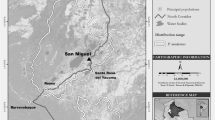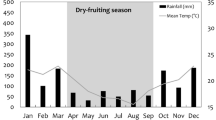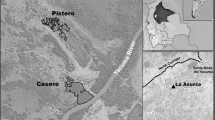With group sizes sometimes >300 individuals, the Angolan black-and-white colobus (Colobus angolensis ruwenzorii) population in Nyungwe Forest, Rwanda is an intriguing exception to the tendency for folivores to live in smaller groups than expected relative to body size. Researchers have hypothesized that the unusually high quality of foliage at Nyungwe allows colobus there to avoid intragroup feeding competition, releasing constraints on the formation of large groups (Fimbel et al., 2001). We collected data on the activity and ranging patterns of a >300-member Nyungwe colobus group and compared our results to those from smaller groups in other black-and-white colobus (Colobus spp.) populations. Colobus at Nyungwe spent far more time feeding and moving (62%) and far less time resting (32%) than black-and-white colobus at any other site. The annual home range of the Nyungwe colobus was also many times larger (95% minimum convex polygon: 20.7 km2; 95% fixed kernel: 24.4 km2) than those for other populations. We terminated our research after the group engaged in an unprecedented migration among black-and-white colobus by moving 13 km south of their former range. Our results suggest that intragroup scramble competition may be more intense than originally believed within the large colobus groups at Nyungwe and that long periods of resource renewal may be necessary after a large colobus group passes through an area, thereby potentially helping to explain their wide ranging patterns. We discuss the socioecological convergence between the Nyungwe colobus and Chinese snub-nosed monkeys (Rhinopithecus spp.) and suggest directions for future research on the unique black-and-white colobus population at Nyungwe.






Similar content being viewed by others
Notes
The term black-and-white colobus as used here refers to all 5 Colobus spp. collectively as in Groves (2001).
REFERENCES
Anonymous. (2004). Nyungwe now a National Park. Wildl. Conserv. 107: 10.
Bennett, E. L. (1986). Environmental correlates of ranging behavior in the banded langur, Presbytis melalophos. Folia Primatol. 47: 26–38.
Bleisch, W. V., Cheng, A. S., Ren, X. D., and Xie, J. H. (1993). Preliminary results from a field study of wild Guizhou snub-nosed monkeys (Rhinopithecus brelichi). Folia Primatol. 60: 72–82.
Bleisch, W. V., and Xie, J. (1998). Ecology and behavior of the Guizhou snub-nosed langur (Rhinopithecus [Rhinopithecus] brelichi), with a discussion of socioecology in the genus. In Jablonski, N. G. (ed.), The Natural History of the Doucs and Snub-Nosed Monkeys. World Scientific Press, Singapore, pp. 217–239.
Bocian, C. M. (1997). Niche Separation of Black-and-White Colobus Monkeys (Colobus angolensis and C. guereza) in the Ituri Forest. Ph.D. thesis, City University of New York, New York.
Boesch, C., and Boesch, H. (1989). Hunting behaviour of wild chimpanzees in Taï National Park. Am. J. Phys. Anthropol. 78: 547–573.
Boinski, S. (1987). Habitat use by squirrel monkeys (Saimiri oerstedii) in Costa Rica. Folia Primatol. 49: 151–167.
Breslin, P., Frunzi, N., Napoleon, E., and Ormsby, T. (1999). Getting to Know ArcView GIS. ESRI Press, Redlands.
Brugiere, D., Gautier, J.-P., Moungazi, A., and Gautier-Hion, A. (2002). Primate diet and biomass in relation to vegetation composition and fruiting phenology in a rain forest in Gabon. Int. J. Primatol. 23: 999–1024.
Chapman, C. A., and Pavelka, M. S. M. (2005). Group size in folivorous primates: Ecological constraints and the possible influence of social factors. Primates 46: 1–9.
Clutton-Brock, T. H. (1975). Ranging behavior of red colobus (Procolobus badius tephrosceles) in the Gombe National Park. Anim. Behav. 23: 706–722.
Clutton-Brock, T. H. (1977). Appendix I. Methodology and measurement. In Clutton-Brock, T. H. (ed.), Primate Ecology. Academic Press, London, pp. 585–590.
Clutton-Brock, T. H., and Harvey, P. H. (1977a). Primate ecology and social organization. J. Zool. (Lond.) 183: 1–39.
Clutton-Brock, T. H., and Harvey, P. H. (1977b). Species differences in feeding and ranging behavior in primates. In Clutton-Brock, T. H. (ed.), Primate Ecology. Academic Press, London, pp. 557–583.
Crockett, C. M., and Janson, C. H. (2000). Infanticide in red howlers: Female group size, male membership, and a possible link to folivory. In van Schaik, C. P., and Janson, C. H. (eds.), Infanticide by Males and Its Implications. Cambridge University Press, Cambridge, UK, pp. 75–98.
Dasilva, G. L. (1989). The Ecology of the Western Black and White Colobus (Colobus polykomos polykomos Zimmerman 1780) on a Riverine Island in South-Eastern Sierra Leone. Ph.D. thesis, University of Oxford, Oxford.
Dasilva, G. L. (1992). The western black-and-white colobus as a low-energy strategist: Activity budgets, energy expenditure and energy intake. J. Anim. Ecol. 61: 79–91.
Dasilva, G. L. (1993). Postural changes and behavioural thermoregulation in Colobus polykomos: The effect of climate and diet. Afr. J. Ecol. 31: 226–241.
Dominy, N. J., and Duncan, B. (2001). GPS and GIS methods in an African rain forest: Applications to tropical ecology and conservation. Conserv. Ecol. 5: 6. [online]: http://www.consecol.org/vol5/iss2/art6
Fashing, P. J. (1999). The Behavioral Ecology of an African Colobine Monkey: Diet, Range Use, and Patterns of Intergroup Aggression in Eastern Black and White Colobus Monkeys (Colobus guereza). Ph.D. thesis, Columbia University, New York.
Fashing, P. J. (2001). Activity and ranging patterns of guerezas in the Kakamega Forest: Intergroup variation and implications for intragroup feeding competition. Int. J. Primatol. 22: 549–577.
Fashing, P. J. (2006). African colobine monkeys: Patterns of between-group interaction. In Campbell, C., Fuentes, A., MacKinnon, K., Panger, M., and Bearder, S. (eds.), Primates in Perspective. Oxford University Press, Oxford, pp. 201--224.
Fashing, P. J., and Gathua, J. M. (2004). Spatial variability in the vegetation structure and composition of an East African rain forest. Afr. J. Ecol. 42: 189–197.
Fimbel, C., Vedder, A., Dierenfeld, E., and Mulindahabi, F. (2001). An ecological basis for large group size in Colobus angolensis in the Nyungwe Forest, Rwanda. Afr. J. Ecol. 39: 83–92.
Fimbel, R. A., and Kristensen, K. A. (1994). Gold Mining Activities Within the UGZ 4 Management Zone, Nyungwe Forest, Rwanda. Report to WCS.
Fleury, M.-C. and Gautier-Hion, A. (1999). Seminomadic ranging in a population of black colobus (Colobus satanas) in Gabon and its ecological correlates. Int. J. Primatol. 20: 491–509.
Gillespie, T. R., and Chapman, C. A. (2001). Determinants of group size in the red colobus monkey (Procolobus badius): An evaluation of the generality of the ecological-constraints model. Behav. Ecol. Sociobiol. 50: 329–338.
Grimes, K. H. (2000) Guereza Dietary and Behavioural Patterns at the Entebbe Botanical Gardens. Ph.D. thesis, The University of Calgary, Calgary.
Groves, C. P. (1973). Notes on the ecology and behaviour of the Angola colobus (Colobus angolensis P. L. Sclater 1860) in N. E. Tanzania. Folia Primatol. 20: 12–26.
Groves, C. P. (2001). Primate Taxonomy. Smithsonian Institution Press, Washington.
Harrison, M. J. S. (1986). Feeding ecology of black colobus, Colobus satanas, in central Gabon. In Else, J. G., and Lee, P. C. (eds.), Primate Ecology and Conservation. Cambridge University Press, Cambridge, pp. 31–37.
Hooge, P. N., Eichenlaub, W. M., and Solomon, E. K. (1999). Using GIS to analyze animal movements in the marine environment. Unpublished manuscript and online documentation. [online] : http://www.absc.usgs.gov/glba/gistools/index.htm
Isbell, L. A., Cheney, D. L., and Seyfarth, R. M. (1990). Costs and benefits of home range shifts among vervet monkeys (Cercopithecus aethiops) in Amboseli National Park, Kenya. Behav. Ecol. Sociobiol. 27: 351–358.
Kanga, E. M. (2001). Survey of black and white colobus monkeys (Colobus angolensis palliatus) in Shimba Hills National Reserve and Maluganji Sanctuary, Kenya. Am. Soc. Primatol. Bull. 25: 8–9.
Kanga, E. M., and Heidi, C. M. (1999/2000). Survey of the Angolan black-and-white colobus monkey, Colobus angolensis palliatus, in the Diani Forests, Kenya. Afr. Primat. 4: 50–54.
Kaplin, B. A. (2001). Ranging behavior of two species of guenons (Cercopithecus lhoesti and C. mitis doggetti) in the Nyungwe Forest Reserve, Rwanda. Int. J. Primatol. 22: 521–548.
Kernohan, B. J., Gitzen, R. A., and Millspaugh, J. J. (2001). Analysis of animal space use and movements. In Millspaugh, J. J., and Marzluff, J. M. (eds.), Radio Tracking and Animal Populations. Academic Press, San Diego, pp. 125–166.
Kinnaird, M. F., and O’Brien, T. G. (2000). Comparative movement patterns of two semi-terrestrial cercopithecine primates: The Tana River crested mangabey and the Sulawesi crested black macaque. In Boinski, S., and Garber, P. A. (eds.), On the Move: How and Why Animals Travel in Groups. University of Chicago Press, Chicago, pp. 327–350.
Kirkpatrick, R. C. (1996). Ecology and Behavior of the Yunnan Snub-Nosed Langur (Rhinopithecus bieti, Colobinae). Ph.D. thesis, University of California, Davis.
Kirkpatrick, R. C. (1998). Ecology and behavior of snub-nosed and douc langurs. In Jablonski, N. G. (ed.), The Natural History of the Doucs and Snub-Nosed Monkeys. World Scientific Press, Singapore, pp. 155–190.
Kirkpatrick, R. C., Long, Y. C., Zhong, T., and Xiao, L. (1998). Social organization and range use in the Yunnan snub-nosed monkey Rhinopithecus bieti. Int. J. Primatol. 19: 13–51.
Korstjens, A. H. (2001). The Mob, the Secret Sorority, and the Phantoms: An Analysis of the Socio-ecological Strategies of the Three Colobines at Taϊ. Ph.D. thesis, University of Utrecht, Utrecht.
Li, Y. (2004). The effect of forest clear-cutting on habitat use in Sichuan snub-nosed monkey (Rhinopithecus roxellana) in Shennongjia Nature Reserve, China. Primates 45: 69–72.
Li, Y., Stanford, C. B., and Yang, Y. (2002). Winter feeding tree choice in Sichuan snub-nosed monkeys (Rhinopithecus roxellanae) in Shennongjia Nature Reserve, China. Int. J. Primatol. 23: 657–675.
Maisels, F., Gautier-Hion, A., and Gautier, J.-P. (1994). Diets of two sympatric colobines in Zaire: More evidence on seed-eating in forests on poor soils. Int. J. Primatol. 15: 681–701.
Maisels, F., Keming, E., Kemei, M., and Toh, C. (2001) The extirpation of large mammals and implications for montane forest conservation: The case of the Kilum-Ijim Forest, North-west Province, Cameroon. Oryx 35: 322–331.
McKey, D. B. (1979). Plant Chemical Defenses and the Feeding and Ranging Behavior of Colobus Monkeys in African Rainforests. Ph.D. thesis, University of Michigan, Ann Arbor.
McKey, D. B., and Waterman, P. G. (1982). Ranging behavior of a group of black colobus (Colobus satanas) in the Douala-Edea Reserve, Cameroon. Folia Primatol. 39: 264–304.
Milton, K. (1980). The Foraging Strategy of Howler Monkeys: A Study in Primate Economics. Columbia University Press, New York.
Milton, K. (1998). Physiological ecology of howlers (Alouatta): Energetic and digestive considerations and comparison with the Colobinae. Int. J. Primatol. 19: 513–547.
Moreno-Black, G. S., and Maples, W. R. (1977). Differential habitat utilization of four Cercopithecidae in a Kenyan forest. Folia Primatol. 27: 85–107.
Oates, J. F. (1974). The Ecology and Behaviour of the Black-and-White Colobus Monkey (Colobus guereza Rüppell) in East Africa. Ph.D. thesis, University of London, London.
Oates, J. F. (1977a). The guereza and its food. In Clutton-Brock, T. H. (ed.), Primate Ecology: Studies of Feeding and Ranging Behavior in Lemurs, Monkeys and Apes. Academic Press, New York, pp. 275–321.
Oates, J. F. (1977b). The social life of a black-and-white colobus monkey, Colobus guereza. Z. Tierpsychol. 45: 1–60.
Oates, J. F. (1994). The natural history of African colobines. In Davies, A. G., and Oates, J. F. (eds.), Colobine Monkeys: Their Ecology, Behavior and Evolution. Cambridge University Press, Cambridge, pp. 75–128.
Olson, D. K. (1986). Determining range size for arboreal monkeys: Methods, assumptions, and accuracy. In Taub, D. M., and King, F. A. (eds.), Current Perspectives in Primate Social Dynamics. Van Nostrand Reinhold, New York, pp. 212–227.
Olupot, W., Chapman, C. A., Waser, P., and Isabirye-Basuta, G. (1997). Mangabey (Cercopithecus albigena) ranging patterns in relation to fruit availability and the risk of parasite infection in Kibale National Park, Uganda. Am. J. Primatol. 43: 65–78.
Plumptre, A. J. (1993). The effects of trampling damage by herbivores on the vegetation of the Park National des Volcans, Rwanda. Afr. J. Ecol. 32: 115–129.
Plumptre, A. J., Masozera, M., Fashing, P. J., McNeilage, A., Ewango, C., Kaplin, B. A., and Liengola, I. (2002). Biodiversity Surveys of the Nyungwe Forest Reserve in S.W. Rwanda. WCS Working Papers 18: 1–92.
Robbins, M. M., and McNeilage, A. (2003). Home range and frugivory patterns of mountain gorillas in Bwindi Impenetrable National Park, Uganda. Int. J. Primatol. 24: 467–491.
Schaller, G. B. (1985). China's golden treasure. Int. Wildlife 15: 29–31.
Seaman, D. E., Millspaugh, J. J., Kernohan, B. J., Brundige, G. C., Raedeke, K. J., and Gitzen, R. A. (1999). Effects of sample size on kernel home range estimates. J. Wildl. Manage. 63: 739–747.
Seaman, D. E., and Powell, R. A. (1996). An evaluation of the accuracy of kernel density estimators for home range analysis. Ecology 77: 2075–2085.
Stanford, C. B. (1991). The capped langur in Bangladesh: Behavioral ecology and reproductive tactics. Contrib. Primatol. 26: 1--179.
Stanford, C. B. (1998). Chimpanzee and Red Colobus: The Ecology of Predator and Prey. Harvard University Press, Cambridge.
Steenbeek, R., and van Schaik, C. P. (2001). Competition and group size in Thomas's langurs (Presbytis thomasi): The folivore paradox revisited. Behav. Ecol. Sociobiol. 49: 100--110.
Sterling, E. J., Nguyen, N., and Fashing, P. J. (2000). Spatial patterning in nocturnal prosimians: a review of methods and relevance to studies of sociality. Am. J. Primatol. 51: 3--19.
Su, Y., Ren, R., Yan, K., Li, J., Zhou, Y., Zhu, Z., Hu, Z., and Hu, Y. (1998). Preliminary survey of the home range and ranging behavior of golden monkeys (Rhinopithecus [Rhinopithecus] roxellana) in Shennongjia National Natural Reserve, Hubei, China. In Jablonski, N. G.. (ed.), The Natural History of the Doucs and Snub-Nosed Monkeys. World Scientific Press, Singapore, pp. 255–277.
Sun, C., Kaplin, B. A., Kristensen, K. A., Munyaligoga, V., Mvukiyumwami, J., Kajondo, K., and Moermond, T. C. (1996). Tree phenology in a tropical montane forest in Rwanda. Biotropica 28: 668–681.
Suzuki, A. (1979). The variation and adaptation of social groups of chimpanzees and black and white colobus monkeys. In Bernstein, I. S., and Smith, E. O. (eds.), Primate Ecology and Human Origins. Garland, New York, pp. 153–173.
Teichroeb, J. A., Saj, T. L., Paterson, J. D., and Sicotte, P. (2003). Effect of group size on activity budgets of Colobus vellerosus in Ghana. Int. J. Primatol. 24: 743–758.
van Schaik, C. P. (1989). The ecology of social relationships amongst female primates. In Standen, V., and Foley, R. A. (eds.), Comparative Socioecology: The Behavioral Ecology of Humans and Other Mammals. Blackwell, Oxford, pp. 195–218.
Vedder, A., and Fashing, P. J. (2002). Diet of a 300-member Angolan colobus monkey (Colobus angolensis) supergroup in the Nyungwe Forest, Rwanda. Am. J. Phys. Anthropol. S34: 159–160.
Vie, J. C., Richard-Hansen, C., and Fournier-Chambrillon, C. (2001). Abundance, use of space, and activity patterns of white-faced sakis (Pithecia pithecia) in French Guiana. Am. J. Primatol. 55: 203–221.
Watts, D. P. (1987). Effects of mountain gorilla foraging activities on the productivity of their food species. Afr. J. Ecol. 25: 155–163.
Watts, D. P. (1998). Long-term habitat use by mountain gorillas (Gorilla gorilla beringei). 1. Consistency, variation, and home range size and stability. Int. J. Primatol. 19: 651–680.
Watts, D. P., and Mitani, J. C. (2002). Hunting behavior of chimpanzees at Ngogo, Kibale National Park, Uganda. Int. J. Primatol. 23: 1–28.
Weber, W. (1989). Conservation and Development on the Zaire-Nile Divide: An Analysis of Value Conflicts and Convergence in the Management of Afromontane Forests in Rwanda. Ph.D. thesis, University of Wisconsin.
Worton, B. J. (1987). A review of models of home range for animal movement. Ecol. Modell. 38: 277–298.
Worton, B. J. (1989). Kernel methods for estimating the utilization distribution in home-range studies. Ecology 70: 164–168.
Zhang, S.-Y. (1995). Activity and ranging patterns in relation to fruit utilization by brown capuchins (Cebus apella) in French Guiana. Int. J. Primatol. 16: 489–507.
ACKNOWLEDGMENTS
We thank L’Office Rwandaise du Tourisme et des Parcs Nationaux for permission to conduct research in Nyungwe Forest. We also thank the Projet Conservation de la Forêt de Nyungwe/Wildlife Conservation Society (WCS) staff for their vital assistance clearing paths and tracking colobus across difficult terrain. A New York Consortium in Evolutionary Primatology/WCS postdoctoral fellowship supported P. Fashing's research at Nyungwe, and WCS funded the remainder of the research. We thank Mark Fashing, Tara Harris, and Gillian Woolmer for advice regarding ArcView.
Author information
Authors and Affiliations
Corresponding author
Rights and permissions
About this article
Cite this article
Fashing, P.J., Mulindahabi, F., Gakima, JB. et al. Activity and Ranging Patterns of Colobus angolensis ruwenzorii in Nyungwe Forest, Rwanda: Possible Costs of Large Group Size. Int J Primatol 28, 529–550 (2007). https://doi.org/10.1007/s10764-006-9095-3
Received:
Revised:
Accepted:
Published:
Issue Date:
DOI: https://doi.org/10.1007/s10764-006-9095-3




